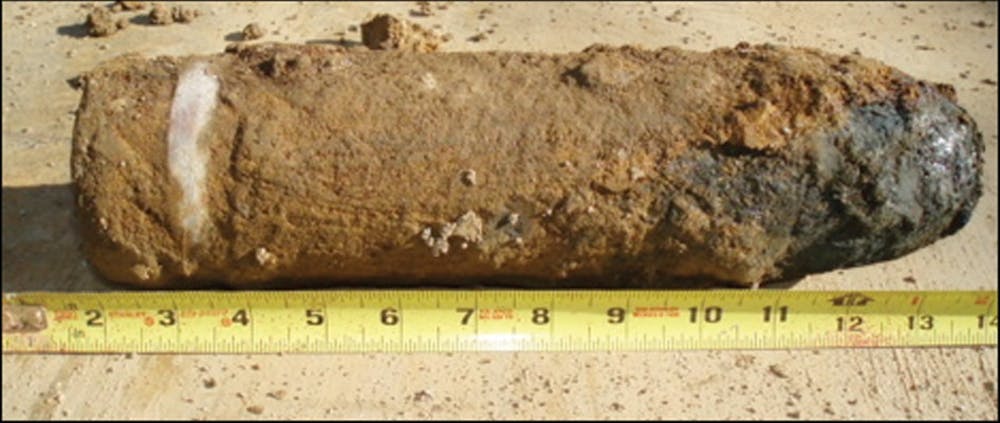The Army Corps of Engineers unearthed more munitions debris next to the Public Safety building during this winter break.
On Jan. 4, workers found a single 75mm round buried four feet underneath a concrete slab that they had removed in front of the building’s lower entrance, according to the U.S. Army Corps of Engineers Project Manager Dan Noble.
Although heavily corroded and empty, the projectile was still largely intact.
Noble said the round was a “closed cavity item,” or had an internal space that was totally sealed off. Such items undergo an X-ray and, if determined to be empty, a subsequent destruction process eliminating potential trace chemicals.
David Taylor, President Neil Kerwin’s chief of staff, confirmed that the operation around Public Safety remains “low probability,” meaning it will be conducted without a vapor or blast containment structure in place and without a safety boundary established.
Noble’s team decided to investigate under the pathway leading to the lower entrance after initial investigations in the area revealed high levels of metals in the soil, he said.
Noble also mentioned that the Corps had consulted the university administration to determine a time period that would be appropriate.
Safety regulations require the Public Safety building to have at least two open entrances, and the ongoing “Lot 18” investigation, the area under construction behind the building, forced workers to wait until the back entrance was made accessible before they could continue out front.
Since the onset of its “Lot 18” investigation, the Corps has uncovered “tons and tons” of debris, according to Noble. This has included everything from inconsequential laboratory glassware to a bottle of lewisite, a blister agent with an LD50, or median lethal dose, that is 100 times more potent than regular chemical agent mustard.
Kent Slowinski, a community activist and former Restoration Advisory Board member, said recent work conducted by the Army Corps indicates a likelihood that the debris field around the Public Safety building extends underneath the building, because debris from the AU Experimental Station has been found behind and in front of it.
Most of the debris items, however, have been regarded as harmless scraps, Noble said.
At previous RAB meetings, Noble has said one option for the Corps to investigate underneath the Public Safety building would be a technique called horizontal drilling, which would allow the Corps to remove cylindrical soil samples from the earth under the building without disturbing the structure.
Skeptics of this method have raised concerns at previous RAB meetings that the risk of the Corps potentially missing something is too high.
Slowinski said he thought this type of drilling would be dangerous, especially if there were more munitions below the building.
“First of all, you’re sampling blind,” he said. “You don’t know what you’re going to run into.”
But Noble added that his team wants to finish all the digging around the building before commencing any further phases of their investigation.
Taylor confirmed that the operation is “winding down,” but that debris collection is ongoing.
Noble also dismissed any apprehension one might have about drilling horizontally under the building.
“If we thought there was that kind of a hazard, we wouldn’t do horizontal drilling,” he said. “Based on everything we’ve found in the debris areas around the building ... we feel confident that we can drill through it.”
You can reach this staff writer at ccottrell@theeagleonline.com.





